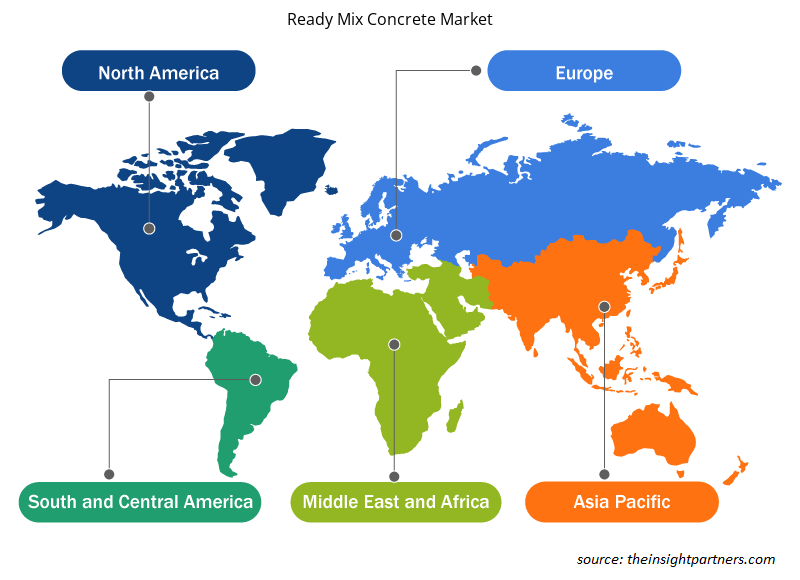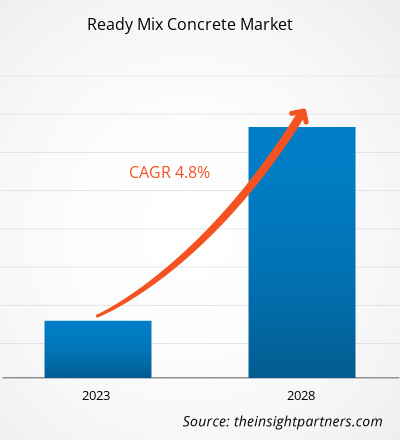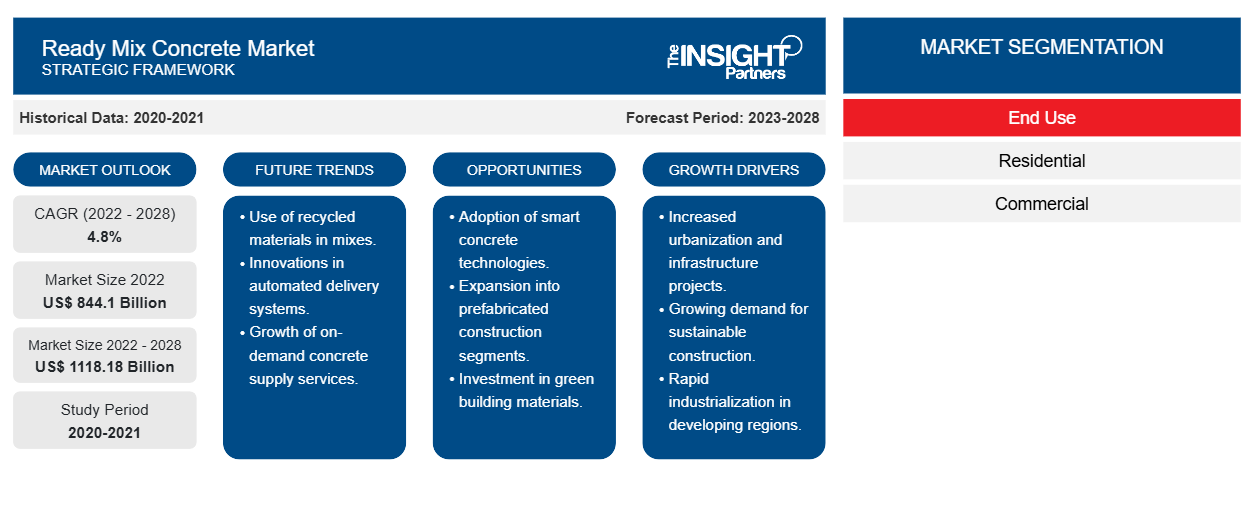Der Markt für Transportbeton soll von 844,10 Milliarden US-Dollar im Jahr 2022 auf 1.118,18 Milliarden US-Dollar im Jahr 2028 wachsen; von 2022 bis 2028 wird mit einer durchschnittlichen jährlichen Wachstumsrate von 4,8 % gerechnet.
Transportbeton wird in einer Betonmischanlage entsprechend den spezifischen Anforderungen der Baustelle hergestellt. Transportbeton, Schrumpfbeton und Zentralbeton sind einige der am häufigsten verwendeten Transportbetonarten. Transportbeton wird in einer kontrollierten Umgebung gemischt und kann für eine Reihe von Projekten verwendet werden. Transportbeton ist nachhaltig und hat eine hohe Haltbarkeit, was zu seiner hohen Nachfrage in verschiedenen Anwendungen führt.
Im Jahr 2021 hatte der asiatisch-pazifische Raum den größten Umsatzanteil am weltweiten Transportbetonmarkt . Aufgrund der steigenden Bautätigkeit gilt die Region als einer der wichtigsten Märkte für die Verwendung von Transportbeton. Die wachsende Zahl der Transportbetonanwendungen in zahlreichen Wohn- und Nichtwohnsektoren dürfte die Nachfrage nach Transportbeton im asiatisch-pazifischen Raum weiter steigern. Darüber hinaus fördern staatliche Initiativen und Richtlinien wie Make-in-India den Aufbau verschiedener Produktionsstätten in Indien.
Passen Sie diesen Bericht Ihren Anforderungen an
Sie erhalten kostenlose Anpassungen an jedem Bericht, einschließlich Teilen dieses Berichts oder einer Analyse auf Länderebene, eines Excel-Datenpakets sowie tolle Angebote und Rabatte für Start-ups und Universitäten.
-
Holen Sie sich die wichtigsten Markttrends aus diesem Bericht.Dieses KOSTENLOSE Beispiel umfasst eine Datenanalyse von Markttrends bis hin zu Schätzungen und Prognosen.
Auswirkungen der COVID-19-Pandemie auf den Transportbetonmarkt
Vor der COVID-19-Pandemie wurde der Transportbetonmarkt hauptsächlich durch seine zunehmende Verwendung in Wohn- und Gewerbeanwendungen angetrieben. Im Jahr 2020 mussten jedoch verschiedene Branchen ihren Betrieb aufgrund von Störungen der Wertschöpfungsketten verlangsamen, die durch die Schließung nationaler und internationaler Grenzen im Zuge der COVID-19-Pandemie verursacht wurden. Die Baubranche wurde hart getroffen, was sich negativ auf den Transportbetonverbrauch in verschiedenen Regionen auswirkte. Darüber hinaus stoppten die Unterbrechungen der Lieferkette die Herstellung und den Vertrieb von Baumaterialien. Bauherren erlebten steigende Kosten und Verzögerungen bei importierten Rohstoffen und Baumaterialien außerhalb der Baustelle, da viele Fabriken für längere Zeit geschlossen waren. Der Bau von Gebäuden war in Europa aufgrund des Mangels an Arbeitskräften und der unterbrochenen Lieferkette für Rohstoffe fast vernachlässigbar.
Im Jahr 2021 begannen jedoch verschiedene Länder, die Beschränkungen zu lockern. Der globale Markt begann sich von den Verlusten zu erholen. Den Herstellern wurde erlaubt, mit voller Kapazität zu arbeiten, was ihnen half, die Versorgungslücke zu überwinden. In Europa sind verschiedene Branchen, darunter die Baubranche, wieder auf Kurs, da die Versorgungsengpässe, die diese Branchen betrafen, allmählich behoben werden. Die steigende Nachfrage nach Transportbeton für verschiedene Industrieanwendungen und die zunehmenden Initiativen staatlicher Stellen zur Bekämpfung von COVID-19 dürften den Transportbetonmarkt weltweit erheblich ankurbeln.
Markteinblicke
Anstieg der Gewerbe- und Wohnungsbauprojekte
Transportbeton wird aufgrund von Vorteilen wie verkürzter Bauzeit, geringen Wartungskosten und Vielseitigkeit in fast allen Bauprojekten verwendet. Das schnelle Bevölkerungswachstum hat Regierungsstellen dazu veranlasst, Reformen in der Stadtplanung voranzutreiben. So ist die Bevölkerung Dubais von 2020 bis 2022 um 0,1 Millionen gestiegen, wobei die Regierung bis 2040 eine Bevölkerungszahl von 5,8 Millionen prognostiziert. Die wirtschaftliche Stabilität des Landes, die bessere Konnektivität, die niedrigen Energiekosten und die Diversifizierungsstrategie der Regierung sind die Faktoren, die Investoren und Kunden dazu bewegen, in Wohn- und Gewerbeimmobilien zu investieren. Laut der Europäischen Union wurden 8 % des Europäischen Fonds für regionale Entwicklung (EFRE) zur Stärkung einer nachhaltigen Stadtentwicklung und zur Unterstützung der städtischen Dimension der Kohäsionspolitik bereitgestellt. Die Renovierungswellenstrategie der Europäischen Kommission umfasst Initiativen für bezahlbaren Wohnraum und zielt auf umweltfreundliche Gebäude ab. All diese Faktoren wirken sich positiv auf das Wachstum des Transportbetonmarktes aus.ERDF) allocated 8% to strengthen sustainable urban development and support the cohesion policy's urban dimension. The European Commission’s renovation wave strategy involves affordable housing initiatives and aims for green buildings. All these factors are positively impacting the ready mix concrete market growth.
Endverbrauchsbasierte Erkenntnisse
Basierend auf der Endverwendung ist der globale Transportbetonmarkt in Wohn-, Gewerbe- und sonstige Bereiche unterteilt. Der Marktanteil von Transportbeton im Wohnbereich war im Jahr 2021 am größten. Der Wohnsektor umfasst Privathäuser, Wohnungen und Gebäude. Die Investitionen und Entwicklungsaktivitäten im Bereich der Wohninfrastruktur sind auf die steigende Bevölkerung und Urbanisierung zurückzuführen. Darüber hinaus haben günstige Regierungspolitiken in vielen Ländern zur Errichtung von Wohngebäuden und Transportbetonproduktionsanlagen geführt, was voraussichtlich die Nachfrage nach Transportbeton aus dem Wohnsektor steigern wird.
Einige Akteure auf dem globalen Transportbetonmarkt sind ACC Limited; Vicat SA; LafargeHolcim; Buzzi Unicem SpA; BARNEY AND DICKENSON INC.; RW Sidley, Inc.; CEMEX SAB DE CV; HEIDELBERGCEMENT AG; ULTRATECH CEMENT LTD.; und CROWN CEMENT PLC. Akteure auf dem Transportbetonmarkt konzentrieren sich auf die Bereitstellung hochwertiger Produkte, um die Kundenanforderungen zu erfüllen. Sie konzentrieren sich auch auf Strategien wie Investitionen in Forschungs- und Entwicklungsaktivitäten sowie Fusionen und Übernahmen.
Bericht-Spotlights
- Fortschrittliche Branchentrends in der Transportbetonindustrie helfen den Akteuren bei der Entwicklung wirksamer langfristiger Strategien
- In Industrie- und Entwicklungsländern angewandte Strategien für Unternehmenswachstum
- Quantitative Analyse des Marktes von 2020 bis 2028
- Schätzung der weltweiten Nachfrage nach Transportbeton
- Porters Fünf-Kräfte-Analyse zur Veranschaulichung der Wirksamkeit der in der Branche tätigen Käufer und Lieferanten
- Aktuelle Entwicklungen zum Verständnis des wettbewerbsorientierten Marktszenarios
- Markttrends und -aussichten sowie Faktoren, die das Wachstum des Transportbetonmarktes vorantreiben und bremsen
- Unterstützung im Entscheidungsprozess durch Aufzeigen von Marktstrategien, die das kommerzielle Interesse untermauern und zum Marktwachstum führen
- Die Größe des Transportbetonmarktes an verschiedenen Knotenpunkten
- Detaillierte Übersicht und Segmentierung des Marktes sowie der Dynamik der Transportbetonindustrie
- Die Marktgröße für Transportbeton in verschiedenen Regionen mit vielversprechenden Wachstumschancen
Der globale Markt für Transportbeton ist nach Endverwendung in Wohn-, Gewerbe- und sonstige Bereiche segmentiert.
Regionale Einblicke in den Transportbetonmarkt
Die regionalen Trends und Faktoren, die den Transportbetonmarkt während des Prognosezeitraums beeinflussen, wurden von den Analysten von Insight Partners ausführlich erläutert. In diesem Abschnitt werden auch die Marktsegmente und die Geografie des Transportbetonmarkts in Nordamerika, Europa, im asiatisch-pazifischen Raum, im Nahen Osten und Afrika sowie in Süd- und Mittelamerika erörtert.

- Erhalten Sie regionale Daten zum Transportbetonmarkt
Umfang des Transportbeton-Marktberichts
| Berichtsattribut | Details |
|---|---|
| Marktgröße im Jahr 2022 | 844,1 Milliarden US-Dollar |
| Marktgröße bis 2028 | 1118,18 Milliarden US-Dollar |
| Globale CAGR (2022 - 2028) | 4,8 % |
| Historische Daten | 2020-2021 |
| Prognosezeitraum | 2023–2028 |
| Abgedeckte Segmente |
Nach Endverwendung
|
| Abgedeckte Regionen und Länder |
Nordamerika
|
| Marktführer und wichtige Unternehmensprofile |
|
Marktteilnehmerdichte: Der Einfluss auf die Geschäftsdynamik
Der Markt für Transportbeton wächst rasant, angetrieben durch die steigende Nachfrage der Endverbraucher aufgrund von Faktoren wie sich entwickelnden Verbraucherpräferenzen, technologischen Fortschritten und einem größeren Bewusstsein für die Vorteile des Produkts. Mit steigender Nachfrage erweitern Unternehmen ihr Angebot, entwickeln Innovationen, um die Bedürfnisse der Verbraucher zu erfüllen, und nutzen neue Trends, was das Marktwachstum weiter ankurbelt.
Die Marktteilnehmerdichte bezieht sich auf die Verteilung von Firmen oder Unternehmen, die in einem bestimmten Markt oder einer bestimmten Branche tätig sind. Sie gibt an, wie viele Wettbewerber (Marktteilnehmer) in einem bestimmten Marktraum im Verhältnis zu seiner Größe oder seinem gesamten Marktwert präsent sind.
Die wichtigsten auf dem Transportbetonmarkt tätigen Unternehmen sind:
- ACC Limited
- Vicat SA
- LafargeHolcim
- Buzzi Unicem SpA
- BARNEY UND DICKENSON INC.
Haftungsausschluss : Die oben aufgeführten Unternehmen sind nicht in einer bestimmten Reihenfolge aufgeführt.

- Überblick über die wichtigsten Akteure auf dem Transportbetonmarkt
Firmenprofile
- ACC Limited
- Vicat SA
- LafargeHolcim
- Buzzi Unicem SpA
- BARNEY UND DICKENSON INC.
- RW Sidley, Inc.
- CEMEX SAB DE CV
- HEIDELBERGCEMENT AG
- ULTRATECH CEMENT LTD.
- : CROWN CEMENT PLC.
- Historische Analyse (2 Jahre), Basisjahr, Prognose (7 Jahre) mit CAGR
- PEST- und SWOT-Analyse
- Marktgröße Wert/Volumen – Global, Regional, Land
- Branchen- und Wettbewerbslandschaft
- Excel-Datensatz
Aktuelle Berichte
Erfahrungsberichte
Grund zum Kauf
- Fundierte Entscheidungsfindung
- Marktdynamik verstehen
- Wettbewerbsanalyse
- Kundeneinblicke
- Marktprognosen
- Risikominimierung
- Strategische Planung
- Investitionsbegründung
- Identifizierung neuer Märkte
- Verbesserung von Marketingstrategien
- Steigerung der Betriebseffizienz
- Anpassung an regulatorische Trends























 Kostenlose Probe anfordern für - Markt für Transportbeton
Kostenlose Probe anfordern für - Markt für Transportbeton